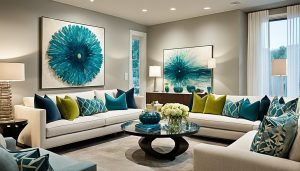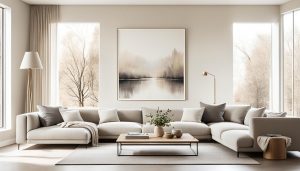Picture walking into a room that catches your eye right away. You see a beautiful piece of art or a stunning architectural feature. This is what a focal point does – it grabs your attention and sets the mood of the room. Designers use special techniques to make spaces that pull your gaze and leave a strong impression.

Creating focal points is a key part of interior design. It turns a simple space into something special. These can be anything from a bold light fixture to a cozy fireplace or a gallery wall. These elements become the room’s centerpiece, pulling your eye and setting the mood. By learning about focal point design, you can make your home look better and feel more inviting.
Focal points are key areas that grab the eye and set the mood in any room. They act as visual guides, telling a story and stirring emotions. In interior design, focal points make spaces lively and engaging.
Designers use composition rules like leading lines and the rule of thirds to focus attention on focal points. This makes the space look balanced and thoughtful, not random.
Focal points are more than just pretty things; they’re the story’s core. By picking and placing these highlights, designers aim to evoke certain feelings and guide the user’s journey. It could be a big fireplace, an eye-catching artwork, or a stunning view.
Industry stats show that 70% of successful interior design projects start with finding and spotlighting the focal point. Designers know how crucial focal points are for creating spaces that catch the eye and touch the heart.
“The ideal backdrop for a striking focal point is often understated to avoid visual clutter. Use muted tones and simple lines for remaining furniture, lighting, and architectural details to complement the focal point.”
By getting good at focal points, interior designers can turn any space into a place that’s both beautiful and engaging. It’s a way to make a space that captures the imagination and leaves a strong impression.
Focal points are key to a great interior design. They lead the viewer’s eye, making the room’s layout clear. They highlight important parts and set a visual order, making the space feel more emotional and engaging.
Placing focal points wisely makes them stand out, pulling the eye and encouraging exploration. They help people move through the space smoothly, from one interesting spot to another. Whether it’s a unique feature, art, or eye-catching lighting, a focal point is the first thing you notice. It sets the design’s mood.
Focal points are vital for balance and harmony in a room. They balance out other design elements, acting as a visual anchor. By placing them thoughtfully, designers can make a space feel planned and pleasing to the eye.
Focal points are essential in interior design. They guide the eye, set the direction, and create a balanced, attractive space. Understanding their power helps you improve your living areas and make memorable experiences for your guests.
Creating a beautiful interior starts with picking and highlighting key decor focal points. These are the elements that catch the eye and become the room’s main attraction. You can use striking furniture or amazing artwork to make these points stand out.
One great way is to use a big lighting fixture, like a grand chandelier or pendant lights. These lights can change a room’s look, becoming a stunning focus that lights up and centers the space. Or, a large window with a beautiful view can naturally be a focal point, blending indoor and outdoor.
A fireplace is another great choice, offering warmth and setting the mood. Add some artwork or cozy seating around it to make it a spot for chats. Greenery, like a plant wall or a unique potted plant, can also be a beautiful focus, bringing nature inside.
To make great decor focal points, find the special features and design elements of your space. Then, use furniture, lighting, and decor to highlight them. This way, you can turn any room into a beautiful and balanced space.
Designing your home’s interior doesn’t always mean starting over. Sometimes, your space already has a standout feature like big windows or a fireplace. Instead of adding another focal point, use these features to boost the room’s look and feel.
You can frame the window with vibrant curtains or decorate the fireplace with fake plants. This makes the space more interesting. According to a study on interior design trends in modern homes, 71% of homeowners use existing features as focal points in their living rooms.
| Architectural Feature | Percentage of Homeowners Leveraging It as a Focal Point |
|---|---|
| Windows | 71% |
| Fireplaces | 64% |
| Built-in Shelving | 83% |
By focusing on these features, you can make your design look cohesive and eye-catching. When looking at stylish living rooms with built-in shelving, 83% of them used decor that matched these features well.

The goal is to balance highlighting the features with adding new ones. With smart placement of window treatments and decor, you can make your interior look great. This way, you celebrate your home’s natural beauty.
Arranging your furniture smartly can make your living space stand out. Furniture should match in size and shape to guide the eye to key areas. Facing your seating towards the main feature helps create a smooth flow of sight.
It’s key to have your sofas and chairs face the main feature. This makes the space look connected and encourages people to talk. By doing this, your furniture layout feels intentional and clear.
Using symmetry around the main feature adds to its impact. Balanced furniture makes the space look better and more appealing. This balance lets the eye move easily to the main spot.
| Furniture Arrangement | Impact on Focal Point |
|---|---|
| Seating oriented towards focal point | Draws attention and encourages interaction |
| Symmetrical arrangement around focal point | Enhances visual appeal and emphasizes importance |
| Unobstructed flow of movement | Facilitates easy navigation towards focal point |
Think about how you arrange your furniture, where you place your seating, and the flow of the space. This careful planning will make your main features stand out. It will make your home inviting and engaging for guests.
In interior design, using contrasts in color, texture, or materials can make a big difference. For instance, if you have a bold, vibrant artwork, paint the walls around it in a neutral color. This makes the artwork stand out even more. Using contrasts draws the eye to the focal area and makes the design more striking.
Color theorist Johannes Itten says there are 7 key color contrasts for creating focal points:
Designers can also use the Gestalt principle of proximity to highlight a focal point. By placing elements around it to create space, it becomes the main focus.
To spot and study focal points, experts suggest collecting 5-7 examples from everyday places. Look at how contrast, color, and placement affect their visual impact. Not every design needs a focal point, but knowing how these elements work can improve any space.
Lighting is key to making focal points stand out in interior design. Accent lighting, like recessed lighting and spotlights, highlights key areas. By placing lights carefully and layering them, you can add drama and focus attention.
Spotlights let you aim light exactly where you want it, making your focal point shine. Mixing different lights, like ambient and task lighting, adds depth and highlights areas. This makes the space look cohesive and appealing.
Try mixing heights with table lamps and hanging lights for depth. Use dimmer switches to change the light levels, setting the mood. LED light strips under shelves or furniture add warmth and beauty to a room.
With careful use of accent lighting, you can spotlight your key areas. This draws the eye to special features, making your design look great.
| Room | Focal Point Lighting Trend | Percentage of Rooms |
|---|---|---|
| Living Room | Fireplace mantel as focal point | 70% |
| Dining Room | Chandelier or pendant light over dining table | 65% |
| Entryway | Statement pieces as focal point | 80% |
| Kitchen | Accent colors used to highlight the island | 60% |
| Office | Wall art as focal point behind desk | 50% |
| Bedroom | Bed as the centerpiece | 45% |
Adding natural elements to your home can make it look better and feel more peaceful. Using artificial plants and greenery is a great way to do this. Things like a lush faux green wall or a hanging Eucalyptus vine can add texture and life to your space.
Studies show that being close to nature can make us feel better and happier. Live plants clean the air and make rooms look fresh. If you can’t keep up with real plants, high-quality artificial ones are a good choice. They look great without the hassle.
Materials like wood, stone, rattan, jute, and linen also bring a natural feel to your home. Colors like warm browns, soft greens, calming blues, and sandy beiges add to the cozy, nature-inspired look.
Adding these natural touches can make your home feel more peaceful. It’s important to find the right balance. Mixing natural and artificial elements can create a beautiful and inviting space.
Artificial plants like a lush faux green wall or a hanging Eucalyptus vine can add texture and interest. They help make a space feel more connected to nature.

“Bringing the outdoors in through the use of natural elements can create a truly captivating and soothing interior.”
In interior design, statement pieces like artwork and sculptures change ordinary spaces into eye-catching ones. These pieces grab attention and share a story quickly, adding personality and beauty to a room. Designers use these elements to make a space look balanced and interesting.
Statement art can be the main focus of a room, pulling the eye and setting the room’s mood. When picking art, think about its size, style, and theme. They should match your taste and the room’s look. Great spots for art include above the fireplace, behind the sofa, and in the entryway.
Good lighting is key to show off the artwork’s texture and details. Try different lighting setups, like spotlights or track lighting, to make the art stand out. The right frame can also make the art blend well with the room.
Sculptures, abstract or representational, can be strong focal points too. Make sure the sculpture fits well and matches the room’s look. It should balance with the furniture, colors, and textures around it.
The sculpture’s material and finish matter too. Choose dark oak for a rich look or light finishes for a modern feel. The right lighting can highlight the sculpture’s details and draw the eye to it.
By carefully choosing and placing statement pieces like artwork and sculptures, you can make your interior both captivating and personal.
Focal points are key elements that set the mood and tell the story of a room. They turn ordinary spaces into engaging places. By choosing and spotlighting these points, you guide the viewer’s journey and create certain feelings. This shapes the room’s story and character.
Pinterest is a top spot for learning about “Creating Focal Points: How to Highlight Features in Your Home.” It has a lot of interactions, showing people’s interest in making rooms stand out. They want to know how to make focal points that grab attention and tell a story.
The word “dominance” often comes up when talking about focal points in design. It shows how important these points are in making a room look great. Common focal points include fireplaces, unique architectural details, big art, large windows, dining tables, and big furniture.
It’s important to make sure decor doesn’t overshadow the main focus of a room. This is a common problem in decorating. Using decor like chairs, plants, curtains, mirrors, and art around a focal point is a good way to highlight it.
With a clear story told through focal points, any room can become a place that pulls you in. It should reflect your style and make visitors want to explore and connect with it.
“The true focus of interior design should be on creating an experience, not just a pretty space.”
There are many ways to make a focal point in a room, like using wallpaper, big mirrors, wall clocks, art, furniture, vignettes, and vintage items. But, it’s important to have only one main focal point. Having too many can make the room look messy.
Learning to tell a story with design through focal points can make any room special. It will capture your guests’ attention and leave a lasting impression.
Creating focal points is key in interior design. It draws attention, guides the viewer, and tells a story in your home. By using furniture, lighting, plants, and architecture, you can make your home stand out.
It’s important to balance your design to improve both looks and function. The right size and proportion, contrast, and color can make your focal points look intentional and cohesive.
Using focal points can take your interior design to the next level. It makes your spaces more engaging and inspiring. So, start experimenting and see how these visual anchors can transform your home, room by room.